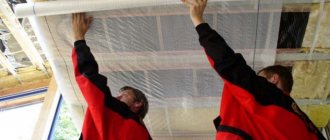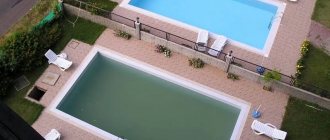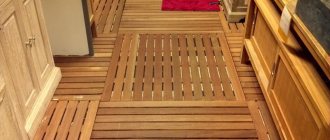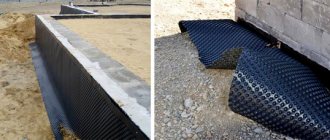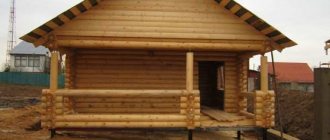An insufficiently insulated bathhouse will cool down quickly and take a long time to warm up. Especially concerning is the problem of bathhouses, which are used all year round. Heat loss will be reduced several times when using isolon. We’ll tell our readers what kind of material this is and how to insulate a bathhouse with isolon.
Izolon is ideal for insulating a bath; it can withstand high temperatures and does not allow water to pass through.
Do not line the bathhouse with foil: problems and harm of aluminum foil
A good sauna heats up quickly and retains heat for a long time.
To achieve this, many people insulate the ceiling and walls. Usually they choose foil. But as an insulator, this material is useless and even harmful. Foil helps reduce heat loss in a steam room and shorten the heating time. But is it? Why then is the house not covered with foil to save heat?
They usually use a thin layer of foil, which is applied to the insulation or craft paper. The material reflects infra. radiation (up to 97%).
Features of insulation
Not all products are used for insulation. Plastic products will deform from high temperatures. If you use plywood or fiberboard, then from the hot air they will begin to expand and change shape, accumulating moisture. These products are definitely not suitable. The best way is to finish in several layers:
- The first step is to use an insulating material that prevents water from penetrating.
- Place a second layer of insulation (for example, mineral wool).
- The third level is aluminum foil.
This “multi-layering” holds heat well and does not allow steam to escape for a long time, so heat losses are reduced.
Insulation materials can be divided into the following types:
- fibers;
- plates;
- blocks;
- wall slabs;
- backfill.
And depending on the composition they distinguish:
- Organic such as ecowool.
- Inorganic - mineral wool.
- Expanded polystyrene.
- Other insulation materials are such as technovent and technoblock.
Minuses
Disadvantages are also important to consider. If you attach foil to a cold wall, the material will show itself negatively. It is imperative to use an additional insulating layer between the wall and the foil.
There is no point in using foil for those who do not save on fuel and who do not care about long heating times. There is no benefit from foil if the bathhouse is sufficiently insulated with other materials.
The absence of foil makes the steam softer and there is no sharp water hammer. For example, sauna logs without foil smooth out temperature shocks well.
Aluminum accumulates in the body. This has a bad effect on a person’s condition and well-being. The metal accumulates in the lungs and negatively affects them. Remember also about aluminum cookware and why almost everyone refuses it. When heated, aluminum cookware releases metal ions. When eating food, aluminum gets ingested.
Source
Which method to choose for insulation inside and outside the room?
The choice of insulation method is influenced by what is located above the ceiling - a cold attic, a residential attic or a flat roof with a low slope, which leaves minimal attic space. In total, there are only three methods for arranging the ceiling:
- grazing;
- hemmed;
- panel.
Flat ceiling insulated with expanded clay, clay and sawdust
For those who have an attic, but do not want to turn it into a warm warehouse or recreation room, the design of a flat ceiling is suitable. It is considered the simplest, since you are not supposed to walk in the attic, which means there is no need even for floor beams. The rough ceiling is placed on the frame of the building, that is, directly on the walls.
Important! There are limitations associated with this. The boards will withstand a layer of insulation if their length is no more than 2.5 m with a board thickness of 4–5 cm.
Different materials can be used, but the structure of the “pie” is the same in any case. It consists of layers (from top to bottom):
- insulation;
- wax paper;
- boards;
- vapor barriers;
- finished ceiling.
The layout of a flat ceiling with insulation is very simple
The vapor barrier material must not only be hydrophobic, but also withstand high temperatures, so its choice is limited. Most often, foil is used as a vapor barrier. The last layer is made of expanded clay (slag) or clay with straw.
In the first case, expanded clay is poured in a layer of 20 to 30 cm onto a layer of waxed paper (so that it does not spill through the cracks). This thickness is enough for the thermal insulation properties of this material to manifest themselves. Expanded clay fractions should be taken different so that the small ones fill the voids between the large ones.
Often, before filling, divider boards are placed on the rough ceiling from the attic side.
The appearance of a flat ceiling insulated with clay is no worse than when using modern materials
How to insulate a bathhouse with isolon with your own hands
An insufficiently insulated bathhouse will cool down quickly and take a long time to warm up. Especially concerning is the problem of bathhouses, which are used all year round. Heat loss will be reduced several times when using isolon. We’ll tell our readers what kind of material this is and how to insulate a bathhouse with isolon.
Izolon is ideal for insulating a bath; it can withstand high temperatures and does not allow water to pass through.
Selection of insulation material
The modern construction market offers a fairly wide range of such materials. But how to make the right choice specifically for your bath? Since they are all fairly new, you can get confused about their differences.
By the way, please pay attention to the following point: the polymers that make up the substrate may have different structures. Namely, they can consist of polypropylene foam and polyethylene foam. We will not go into details, but the first option is suitable for high temperatures, the second is relevant for less aggressive environments.
Here are some technical characteristics that I hope will help you choose the right one from the most popular materials at the moment.
Penotherm
Izospan FB
- Penotherm is distinguished by a base made of foamed propylene foam and a wide operating temperature range - from -40°C to +150°C. Certificates confirm its moderate flammability and low-hazard toxicity class. There is virtually no thermal shrinkage during operation. The NPPLE model can be used when installing heated floors. Great for a steam room.
- Izospan FB is intended directly for creating a vapor barrier in baths and saunas. It can be safely used at high temperatures. You can read more about the many labels and uses of isospan in this article.
- Alufom has a base made of polyethylene foam and one-sided coating with aluminum foil. The temperature range is from -60°C to +100°C. In addition to the functions of hydro, sound, steam and thermal insulation, it includes protection against radon. Can be used for insulation of floors and roofs. The special “wrinkled” texture of the surface makes it possible during the installation process to bend around curved elements of small radii without tearing the foil coating.
- Tepofol has a polyethylene foam base and may have a reflective layer on one or both sides in different models. Withstands temperatures from -60°C to +100°C. Can be used for thermal insulation of roofs, walls, air ducts, and installation of “warm floors”. It is supplied to the market in various variations.
- Izolon is an environmentally friendly and safe material. The base is also foamed polyethylene foam. It is a durable, vapor-tight, soft and flexible foil insulator.
Alufom AL
Penofol
Izolon - pros and cons
Flexible isolon is easier to install on the walls of a bathhouse with your own hands.
The texture of the material is different and can be flexible or hard, cross-linked (from several layers), homogeneous.
To insulate a bath, you can use any option. Foiled on two or one side will be more effective in a steam room, and unstitched for a rest room or dressing room.
Thanks to its small thickness of 50–100 mm, the insulation will not steal the space of the bathhouse, such as mineral wool or polystyrene foam. But in terms of thermal insulation characteristics, 100 mm thick isolon is equal to a 200 mm layer of mineral wool.
The main advantages of insulating a bathhouse with isola include the following characteristics:
Despite the large number of advantages, isolon has a number of disadvantages:
The disadvantages are mainly associated with improper installation of insulation in the bathhouse or the use of low-quality material. To avoid troubles, buy insulation from well-known brands in large shopping centers. Installation should be carried out according to the instructions.
When choosing a material for insulation, it is worth choosing a roll type, although the manufacturer also offers a block type. It is easier to work with a roll in a small room.
Forewarned is forearmed
When doing insulation with your own hands, you can make a number of mistakes. What you should pay attention to when insulating a bathhouse with isolon:
- Isolon foiled on both sides is used to insulate the steam room. The material will not only reflect heat inward, but also cold outward.
- The joints and places where the isolon is attached must be sealed with tape. Otherwise, moisture will get under the material and the metal fasteners will become corroded.
- The joints between the ceiling insulation and on the walls are also taped.
- The insulation is applied 5 cm away from the floor, so that moisture from below will not get under the material.
- For a small bathhouse in a country house, insulation with a thickness of 50 mm is suitable, for a constantly used steam room - 100 mm.
- Wooden walls must be coated with antiseptic compounds before insulation; they also come with slats for lathing for finishing.
- You should not leave the isolon open for a long time; it can be easily damaged by any hard, heavy object.
- You should not finish a bathhouse made of wood with natural moisture until it shrinks completely, as the isolon may warp.
It is better to attach a natural, breathable finish on top of the isolon, for example, linden lining.
It is better to carry out work in the warm season, since the tape will not stick well at subzero temperatures.
By following all the rules, you can perform high-quality insulation of your bathhouse with isolon. The correct installation will determine when you will have to carry out repair work, which is not cheap. Save your money and personal time, and let the steam in your sauna be light and warm!
Step-by-step instructions on how to insulate a bathhouse with isolon
Before work, it is necessary to calculate the amount of isolon according to the area of the walls and ceiling of the bathhouse. To do this, you need to multiply the length of the wall by the width and multiply between them. The resulting figure is 4. Add the ceiling area to the result and subtract the doorway. The material is laid without overlap, so metallized tape is purchased for a hermetically sealed connection.
The walls of the bathhouse are sheathed with isolon directly onto the wall. You can first perform insulation with mineral wool.
For work you will need materials and tools:
After everything has been purchased, we proceed to insulating the walls and ceiling.
Installation of insulation on the walls and ceiling of a bathhouse
It is necessary to insulate the walls and ceiling of the bathhouse with isolon between the finishing and the inner wall. A ventilated gap of at least 0.5 cm must be left between them so that moisture can evaporate.
Finishing material is attached to the insulation on top.
The work is carried out in the following stages:
The insulation of the steam room is ready, you can begin finishing. More information about how to insulate a steam room can be seen in the video:
Principles of thermal insulation of bath ceilings
Based on the design features of the roof, bathhouses made of logs or timber can be divided into two types: buildings with and without attic space. In the path of warm air flowing out of bathhouses with attics, there will be a much more powerful ceiling, into the layer cake of which thermal insulation material is usually laid during the construction process.
The under-roof space itself, filled with an air mass, also inhibits the leakage of thermal energy, and the insulation of the roof structure also slightly moderates the agility of the “escaping” heat.
However, this does not mean that insulation of the ceiling in a bathhouse with an attic or attic is not necessary. Increasing the thermal insulation characteristics in it is no less necessary than in a building without an attic, where the heat leaking out encounters few and too weak barriers in its path.
Specifics of the vapor barrier device
In both cases, regardless of the roof structure, a vapor barrier is laid on the bathhouse ceiling before laying the heat-insulating layer. To equip a building without an attic space, you can use aluminum foil, compacted cardboard, generously impregnated with drying oil, or wax paper as a vapor barrier layer.
In bathhouses with an attic, the same materials are used, but most often the ceiling boards on the roof side are coated with a two-centimeter layer of clay.
Of the options offered by the industry, the following are used:
- standard polyethylene film (as for greenhouses 0.4 mm with variations) - a type of vapor barrier that is not very popular due to the greenhouse effect;
Note. The use of polyethylene film as insulation requires leaving a gap necessary for condensation to evaporate.
- a special vapor barrier film made of polyethylene with fibers to retain condensation;
- membrane type vapor barrier material.
Vapor barrier is necessary to prevent the transit of wet vapors and their settling in the insulation. After all, water accumulated in the thermal insulation material will shorten its service life, increase the weight of the multilayer ceiling system and, if we return to the physics course, reduce its insulating qualities.
Three functions of bath ceiling insulation
The hotter the room temperature is required, the more difficult it is to build a barrier to retain heat. To solve this difficult problem, those who want to know how to insulate the ceiling of a bathhouse should familiarize themselves with the three main leak patterns:
- movement of heated air through the cracks in the ceiling;
- gradual transition of heat from heated objects to cold ones;
- intersection of homogeneous barriers by thermal waves.
Laying thermal insulation material in a multi-layer roofing system prevents all types of thermal leaks. Properly done insulation will adequately perform all the work assigned to it. Due to poor thermal insulation, condensation will settle on the ceiling, it will take much longer to warm up the room, and more fuel resources will be spent.
Selection of materials for insulation
Before deciding how to insulate the ceiling in a bathhouse, you need to consider all options for suitable thermal insulation materials.
- “Classic” mineral wool is used most often. In its chaotic interweaving of fibers melted from basalt there are billions of air-filled voids, each of which works responsibly to retain heat. Disadvantage: loss of insulating properties when wet.
Note. When using mineral wool to insulate the ceiling in bath buildings, it is recommended to lay a waterproofing layer on top of the insulation if the roof is not sufficiently protected from atmospheric water leaks. A thermal insulation gap must be created between the waterproofing layer and the insulation.
- Super-light polypropylene foam - penotherm - is also often installed on the ceiling of a bathhouse. The foil-laminated material was developed specifically for arranging bath buildings and saunas. In addition to its intended function of insulation, its foil side reflects the flow of thermal energy. Working on the mirror principle, penotherm allows you to reduce the heating time of the steam room by 2-3 times.
- Expanded clay is suitable for large-sized bath structures. The layer sufficient to insulate the ceiling should be 30 cm. Although the material is relatively lightweight, it will inevitably increase the weight of the building. Its porous granules, like mineral wool, are susceptible to moisture. Waterproofing is also necessary.
- "People's" heat insulator. The first element is a 2 cm layer of crumpled clay. Instead, a mix of black soil and peat, wood shavings filled with cement mortar, a mixture of clay, sand or sawdust are suitable. A “carpet” of dry sawdust or leaves (preferably oak) is laid on top of the laid layer, and the insulation is completed by laying a layer of dry earth 15 cm thick.
- Growing aerated concrete, for pouring which a simple formwork is arranged. The video will clearly depict how this insulation of the bathhouse ceiling is carried out: the video demonstrates the simple technology in detail.
It is difficult to recommend the thickness of the insulation layer offhand, without knowing the actual size of heat loss and the technical parameters of the structure. The figures are approximate throughout, variations are allowed. Much depends on the climate zone, because the ceiling insulation in a bathhouse is not only a barrier to heat, but also protection from external temperature factors. If the ceiling freezes from the outside, moisture will certainly condense on the ceiling. In such cases, the thermal insulation layer is simply increased.
Application of foil vapor barrier
If you decide to use such material when building a bathhouse on your summer cottage, this does not mean at all that you need to incur significant expenses. You don't need to invest a lot of money to insulate the entire building. The optimal solution is installation exclusively in the steam room and shower room. The foil layer effectively accumulates heat, and the polymer inside reliably protects the structure from moisture and steam. For other rooms, you can simply purchase simpler and cheaper material.
What can you use?
Before the advent of modern insulation, owners used various natural materials. Sawdust, clay, moss and straw were used. Some baths are still insulated this way.
Its greatest disadvantage is the susceptibility of natural materials to rotting and other biological effects. And clay is also distinguished by its considerable weight. To use it on ceilings, you need to build a fairly massive and durable structure.
All modern insulation materials do not have such a huge disadvantage as heavy weight. They are also distinguished by good resistance to external influences and a long service life.
The most popular and modern ceiling insulation materials include mineral wool, expanded clay and ecowool. Foam and other materials based on plastics cannot be used due to the risk of fire.
When choosing building materials, special attention is paid to:
- resistance to open fire;
- ease of installation;
- environmental cleanliness and safety;
- light weight.
To save space (ceilings in bathhouses are already low), it is preferable to place thermal insulation material in the attic, if there is one. The simplest option is to spread mineral wool and protect it from high humidity with a vapor barrier film.
You can do the insulation work yourself. If you use natural material (for example, sawdust), the entire insulation process will be completely free for the owners.
In case of various difficulties in the installation and use of modern building materials, you will have to turn to professional builders. Payment for their labor is made on a per square meter basis. For example, laying basalt wool costs from 150 rubles per square meter, and glass wool from 90 rubles.
Working with certain types of insulation is quite a difficult task.
Ceiling insulation with foil-isolon
Sheets of foil-isolon should be spread over the surface of the ceiling so that the foil “looks” into the room. After this, the insulation must be pressed with a clamp strip. The foil layer serves to reflect thermal radiation, which can be used as an additional advantage if foil isolon is used together with penoplex or polystyrene foam. In this case, the foil material will act as a vapor barrier.
vote
Article rating


